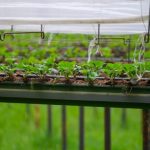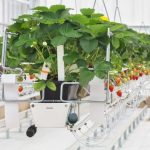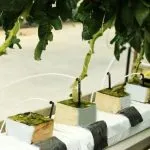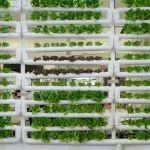Hydroponic drip systems are a form of water-efficient agriculture technology where water and nutrients are delivered directly to the roots through a network of tubes, drippers, and emitters. This system operates on principles of precision watering and optimal nutrient balance. It provides plants with just the right amount of hydration and nourishment they need for growth – not a drop more or less.
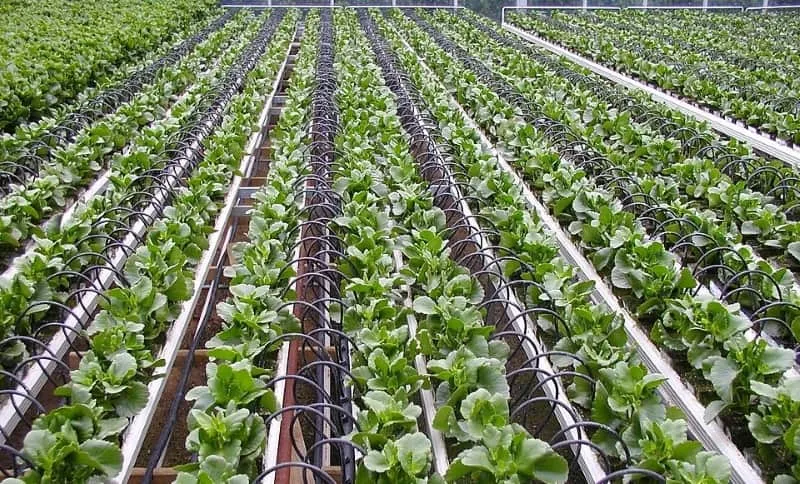
The hydroponic drip system holds many advantages over other hydroponic systems. With its precision irrigation strategy, it conserves more water than other methods, making it eco-friendly and cost-effective. This system is also highly flexible and adaptable to various plant types and growth stages due to its controllable flow rate. Lastly, its scalability makes it suitable for both small home gardens as well as large commercial farms.
Now that we’ve introduced you to what this system is and some key benefits it offers, let’s dive deeper into mastering the hydroponic drip system watering schedule — a critical factor in maximizing your plant’s potential. For a more in-depth look at what drip hydroponics is, take a look at our detailed guide.
- The Importance of Proper Watering in Hydroponics
- Factors Affecting Hydroponic Drip System Watering Schedule
- Determining Water Requirements for Different Plant Species
- Designing an Effective Hydroponic Drip System Watering Schedule
- Fine-tuning the Hydroponic Drip System Watering Schedule
- Techniques for Water Conservation in Drip Hydroponics
- Common Mistakes to Avoid in Hydroponic Drip System Watering
- Troubleshooting Watering Issues in a Hydroponic Drip System
The Importance of Proper Watering in Hydroponics
In hydroponic gardening, water isn’t just a means to keep the plant hydrated; it’s a lifeblood that delivers essential nutrients directly to the roots. Understanding the role this vital resource plays in nutrient absorption and recognizing the impact of both under-watering and over-watering on plant health becomes imperative for successful hydroponic gardening.
Role of Water in Nutrient Absorption
Water serves as an integral vehicle for nutrient delivery in a hydroponic system. It acts as a solvent, dissolving the different nutrients needed by plants and making them readily available for uptake by roots. In traditional soil-based gardening, plant roots need to actively search for these nutrients. But in hydroponics, a well-balanced nutrient solution is directed straight to the root zone ensuring efficient and effective absorption.
The availability of oxygen is another crucial aspect enhanced by proper watering. With enough water movement, oxygen can be sufficiently dissolved and supplied to the root system—vital for respiratory processes that contribute directly to optimal growth rates.
Impact of Under-Watering and Over-Watering on Plant Health
Both under-watering and over-watering pose substantial threats to plant health in a hydroponic setup.
Under-Watering – Under-watered plants can exhibit stunted growth due to a lack of sufficient nutrients and hydration. The risk increases when there’s not enough water to dissolve and transport nutrients or when evaporation outpaces supply. Signs may include wilting leaves, slowed growth, or premature shedding of flowers or fruits.
Over-Watering – Conversely, over-watered plants are equally susceptible to damage—this time from suffocation. Over-watering can prevent adequate oxygen exchange at the roots leading to root rot—a condition where roots become mushy and brown due to lack of oxygen. Additionally, overwatering can cause nutrient leaching where essential minerals are flushed out from the root zone before they have been absorbed.
By attentively managing your drip hydroponics watering schedule and understanding these two extremes (under- & over-watering), you can maintain an ideal equilibrium that promotes vigorous plant growth while minimizing risks associated with incorrect watering practices.
Factors Affecting Hydroponic Drip System Watering Schedule
When deciding on an ideal hydroponics drip system watering cycle for your hydroponic drip system, certain factors play an instrumental role. These include the type of plant species, their growth stage, environmental conditions like temperature and humidity, and finally the type of medium used. Let’s delve into these aspects in more detail.
Plant Species and Growth Stage
Different plant species have various needs when it comes to water intake. Some plants thrive in consistently moist environments, while others prefer dry spells between watering. Understanding your plant’s unique watering requirements is fundamental.
For instance, lettuce tends to have a high water requirement due to its large leaf surface area that facilitates transpiration. On the other hand, plants like tomatoes might require less frequent watering but in larger amounts per session.
Moreover, the growth stage of your plants also influences their water demand. Plants usually need more water during their vegetative growth phase as opposed to germination or fruiting stages. Therefore, adjustment of the watering schedule as per the plants’ life cycle can enhance growth and productivity.
Environmental Conditions (Temperature, Humidity)
Environmental conditions such as temperature and humidity significantly affect a plant’s water needs. Higher temperatures or low humidity levels often lead to increased evaporation rates from both the plant leaves (transpiration) and growing medium surface – which means you’ll likely need to increase the frequency or volume of irrigation.
Conversely, in cooler or highly humid conditions where there are reduced evaporation and transpiration rates, you may need to reduce watering frequency or amount to prevent overwatering which can lead to problems such as root rot.
Medium Type (Substrate or Substrate-less)
The selection of growing medium – whether substrate-based like coconut coir and perlite, or substrate-less mediums like rockwool – also impacts your hydroponic drip system watering schedule.
Substrate-based mediums often require careful monitoring because they can retain moisture for extended periods; hence overwatering could become an issue leading to oxygen deprivation for roots. In contrast, substrate-less systems might necessitate continuous cycling of nutrient solution allowing roots constant access to both nutrients and oxygen dissolved in water but avoiding flooding situations is essential here too.
Related: Drip hydroponics isn’t the only method of growing crops in a soil-less environment that needs precise watering. Check out our guides on an NFT watering schedule and an ebb and flow watering schedule.
Determining Water Requirements for Different Plant Species
In hydroponic gardening, understanding how to meet the water requirements of various plant species is crucial. This involves a meticulous research process about each species’ specific needs and making adjustments based on their growth stage.
Research and Understanding Plant Needs
The first step in determining the water requirements of different plant species is comprehensive research. Every type of plant has unique needs when it comes to water consumption. Some plants thrive in well-moist conditions, while others prefer periods of dryness between watering.
For example, leafy greens like spinach and lettuce generally require more frequent watering due to their high transpiration rate. In contrast, fruit-bearing plants, like cucumbers or tomatoes, may need less frequent watering but with larger volumes per session because they store more water in their fruits.
Use resources like horticulture manuals, scientific publications, or trusted online platforms to gather information regarding your plant’s specific watering needs. Remember that the goal is to mimic the natural conditions that each plant species would typically thrive in.
Adjustments Based on Growth Stage
Once you’ve understood your diverse plants’ unique water demands, the next step is adjusting these requirements based on their current growth stage. The water demand of most plants fluctuates throughout their lifecycle.
During germination and early seedling stages, plants usually need less amount of water as they have lesser leaf surface area for transpiration but this should be provided frequently to keep them moist all times. As they transition into the vegetative phase – where mass foliage development takes place – they will require increased amounts of water to support rapid growth.
When it comes time for flowering and fruit production, the irrigation schedule may need further tweaking. It might seem counterintuitive, but during this stage some plants actually require slightly less water than during vegetative growth as excess moisture can negatively affect blooming or lead to fruit cracking.
A common starting point for many growers using a hydroponic drip system is to run the system for about 10 minutes every hour during daylight hours when the plants are actively photosynthesizing.
Please remember it’s important to keep an eye on your plants’ health: if they show signs of overwatering (yellow leaves) or underwatering (wilting), you may need to adjust accordingly. Always consult specific guidelines for the plant species you are growing as well as recommendations from the manufacturer of your hydroponic system.
In conclusion, a successful hydroponic gardener pays close attention not only to varying plant species but also changing growth phases when determining an efficient watering schedule.
Designing an Effective Hydroponic Drip System Watering Schedule
Creating an effective watering schedule requires careful planning and observation. The process involves two key steps: measuring and monitoring water consumption, followed by developing a baseline schedule, which is then adjusted based on observations.
Step 1: Measuring and Monitoring Water Consumption
To ensure optimal growth conditions for your plants, it’s essential to accurately measure and track their water usage. This begins with employing the right tools for measuring water consumption.
There are various instruments available that can aid in this task. Moisture meters, for instance, can help you monitor the moisture levels in your medium. These devices provide real-time data about your substrate’s water content allowing you to avoid under- or over-watering scenarios.
Other useful equipment includes flow meters attached to your irrigation system which record the quantity of water dispensed each time you irrigate. Similarly, electronic scales placed under your hydroponic reservoir can also indicate changes in water weight over time.
Once you’re equipped with these measurement tools, start tracking the water usage patterns of your plants. Pay attention to factors like how frequently the plants need watering and how much they consume per session.
Step 2: Developing a Baseline Schedule
With a comprehensive understanding of your plants’ water consumption habits, you’re ready to develop an initial watering schedule as a starting point.
Establish a baseline frequency for watering — this could be multiple times daily for crops that prefer consistently moist conditions or less frequent if the plant species require drier periods between irrigation sessions. Also, decide on the duration of each watering session based on plant needs and medium type – some substrates might retain moisture longer than others.
However, creating this baseline schedule is just the beginning; it serves as a dynamic guide rather than a rigid timetable. This means it should be regularly reviewed and adjusted based on ongoing observations of plant health indicators such as leaf coloration, rate of growth, or signs of wilted or droopy leaves indicating possible overwatering or underwatering.
By combining diligent measurements with continuous adjustments based on observed plant responses, you’ll be able to design an effective watering schedule tailored to meet your plants’ specific needs.
Fine-tuning the Hydroponic Drip System Watering Schedule
Once you’ve laid down a baseline watering schedule for your hydroponic drip system, it’s important to fine-tune this plan based on various factors such as changing environmental conditions, different growth stages, and specific plant types.
Adjustments Based on Environmental Conditions
Environmental conditions – particularly temperature fluctuations and humidity levels – can significantly impact your plants’ water needs. It’s crucial to make necessary adjustments to your watering schedule in response to these variations.
Temperature Fluctuations: Higher temperatures increase evaporation and transpiration rates from the plant and growing medium, prompting an increased frequency or volume of irrigation. Conversely, lower temperatures cause less evaporation, which means you may have to decrease the number of watering sessions or their duration.
Humidity Levels: High humidity reduces the rate at which plants lose water through transpiration; therefore, under these conditions, reduce the amount or frequency of irrigation. On the other hand, low humidity levels will necessitate more frequent watering due to enhanced transpirational loss from plant leaves.
Modifying Watering Schedule for Different Growth Stages
Accommodating varying water demands during different growth stages is also vital when fine-tuning your watering schedule.
Seedling Stage: During this initial stage, plants require frequent but small amounts of water. Overwatering can easily damage young roots while underwatering can hinder growth.
Vegetative Stage: As plants transition into this stage characterized by foliage development, they need more water due to increased photosynthesis and transpiration. Thus, both the frequency and volume of watering should be stepped up accordingly.
Flowering and Fruiting Stage: Once plants begin blooming and producing fruits or vegetables, their water requirements slightly decline because excess moisture can adversely affect bloom set or lead to fruit cracking.
Adapting the Schedule for Different Plant Types
Different types of crops have unique water requirements which must be accounted for when adjusting your watering schedule.
Leafy Greens: Plants like lettuce or spinach typically demand high volumes of water delivered frequently due to their large leaf surface area encouraging faster rates of transpiration.
Herbs: Many herbs like basil or rosemary prefer slight dry spells between irrigations. These plants often require less frequent but thorough watering sessions that allow deeper penetration into the growing medium.
Fruiting Plants: Plants such as tomatoes or cucumbers might require less frequent irrigation compared with leafy greens but tend to need larger volumes per session as they store more water in their fruits.
Techniques for Water Conservation in Drip Hydroponics
In hydroponic gardening, water conservation is as important as maintaining a precise watering schedule. Since drip systems are usually chosen because of lower water usage, this becomes a factor worth concentrating on a little more. Not only does it cut down on operating costs, but it also contributes to the sustainability of the system. Here are two key strategies you can implement: setting up recycling systems and using water-efficient components.
Implementing Recycling Systems
A significant advantage of hydroponics over traditional soil-based gardening is its potential for reducing water usage through recycling systems. Unlike regular irrigation methods where excess water drains away carrying nutrients with it, a closed-loop drip hydroponic system allows for recirculation of the nutrient solution.
The idea here is to collect the runoff from your growing medium or trays and return it back into your reservoir. This recaptured nutrient solution can then be reused, minimizing waste and preserving resources. However, ensure that the recycled water is periodically tested and adjusted for pH and nutrient concentration since these elements can fluctuate over time.
Implementing a recycling system not only conserves water but also reduces the amount of nutrients required, making your operation more cost-effective and sustainable. Find out how to build a your own hydroponic drip system kit.
Using Water-Efficient Components
Employing water-efficient components in your hydroponic setup will also help conserve this critical resource while still ensuring optimal growth conditions for your plants.

For instance, drip emitters with pressure compensating features provide uniform flow rates regardless of pressure variation ensuring each plant receives an equal amount of nutrient solution thus avoiding wastage. Furthermore, by automating your system with a reliable timer you can control watering durations more accurately helping to prevent over-irrigation scenarios.
Another effective component could be the use of specialized growing mediums that retain moisture effectively such as coconut coir or vermiculite. These substrates absorb and hold onto the right amount of nutrient-rich solution providing continuous access to roots without unnecessary leakage or evaporation compared to less absorbent mediums.
Common Mistakes to Avoid in Hydroponic Drip System Watering
Having an efficient watering schedule for your hydroponic drip system is critical, but it can be hampered by common mistakes. These errors include over-irrigation leading to nutrient deficiencies or root rot and neglecting to adjust the watering schedule as plants grow.
Over-Irrigation Leading to Nutrient Deficiencies or Root Rot
One of the most common mistakes many hydroponic gardeners make is over-irrigation. While it may seem like providing your plants with more water equals more nutrients, this isn’t necessarily true. In fact, over-irrigation can lead to nutrient deficiencies or even root rot.
When plants receive too much water, their roots become waterlogged, which displaces oxygen that roots need for optimal function. This situation can inhibit the absorption of nutrients leading to deficiencies despite having ample nutrients in the solution. The symptoms might mimic those of under-fertilization such as stunted growth or color changes in leaves making diagnosis tricky.
Furthermore, excessively moist conditions can provide a breeding ground for various fungi causing root rots. Affected plants often display wilted leaves due to damaged roots’ inability to take up water and nutrients effectively.
To avoid these issues, ensure your watering schedule provides sufficient dry periods between irrigations allowing roots access to adequate oxygen and preventing fungal proliferation.
Neglecting to Adjust Watering Schedule as Plants Grow
Another common mistake is failing to adjust the watering schedule as plants progress through different growth stages. Each stage of plant development – from seedling phase through vegetative growth and onto flowering or fruiting – has its unique water requirements.
For instance, during early seedling stage, plants need less amount of water provided frequently. As they transition into the vegetative stage characterized by rapid foliage development, both frequency and volume of watering should increase accordingly. Conversely during blooming or fruit production phases, slight decrease in watering might be required due to potential adverse effects of excess moisture on bloom set or fruit quality.
A static watering schedule that doesn’t account for these changing needs can lead either insufficient hydration impacting growth rate or overwatering potentially causing ailments like root rot.
Therefore, regular monitoring and adjusting your hydroponic drip system’s watering schedule according to plant maturity level is crucial for sustained plant health and optimum productivity.
Troubleshooting Watering Issues in a Hydroponic Drip System
Watering issues are among the most common problems faced by hydroponic gardeners. Recognizing signs of under-watering or over-watering and taking suitable corrective actions can maintain plant health and ensure optimal growth.
Identifying Signs of Under-Watering and Over-Watering
Both under-watering and over-watering have distinct signs that you should watch out for to effectively troubleshoot watering issues.
Wilting or Drooping Plants: Wilting or drooping could be symptoms of both under- and over-watering. Under-watered plants often exhibit wilted leaves as there’s not enough water to sustain firmness. On the other hand, overwatered plants may also display a similar wilting pattern because root damage caused by excessive moisture inhibits effective water uptake causing leaves to droop.
Root Rot or Fungal Growth: Overly saturated growing mediums can lead to fungal growth and root rot. If your plants’ roots appear mushy, discolored (often brown or black), smell foul, or if there’s visible mold on the medium surface, it’s likely due to overwatering.
Corrective Actions for Watering Issues
Once you’ve identified a potential watering issue, take swift corrective action to salvage your crops.
Adjustments to Frequency or Duration: If you notice symptoms of underwatering, increase the frequency or duration of irrigating your plants ensuring they receive adequate hydration. For signs of overwatering, inversely adjust your watering schedule reducing either frequency of irrigation sessions or their duration depending upon severity.
Enhancing Aeration in the Root Zone: Interestingly, both under- and over-watered roots suffer from oxygen deprivation – in the former case because dry roots can’t facilitate oxygen uptake well while in latter due to displacement of air by excess water. Enhance aeration in root zone using methods like adding air stones in your reservoir creating dissolved oxygen-rich solution for roots’ access.
It is also beneficial in case of an overwater situation where it helps dry out waterlogged substrates faster allowing recovery from possible root rot.
Remember that mastering a watering schedule involves constant vigilance – keen observation skills coupled with timely action will help keep your plants healthy even when confronted with watering hitches.

